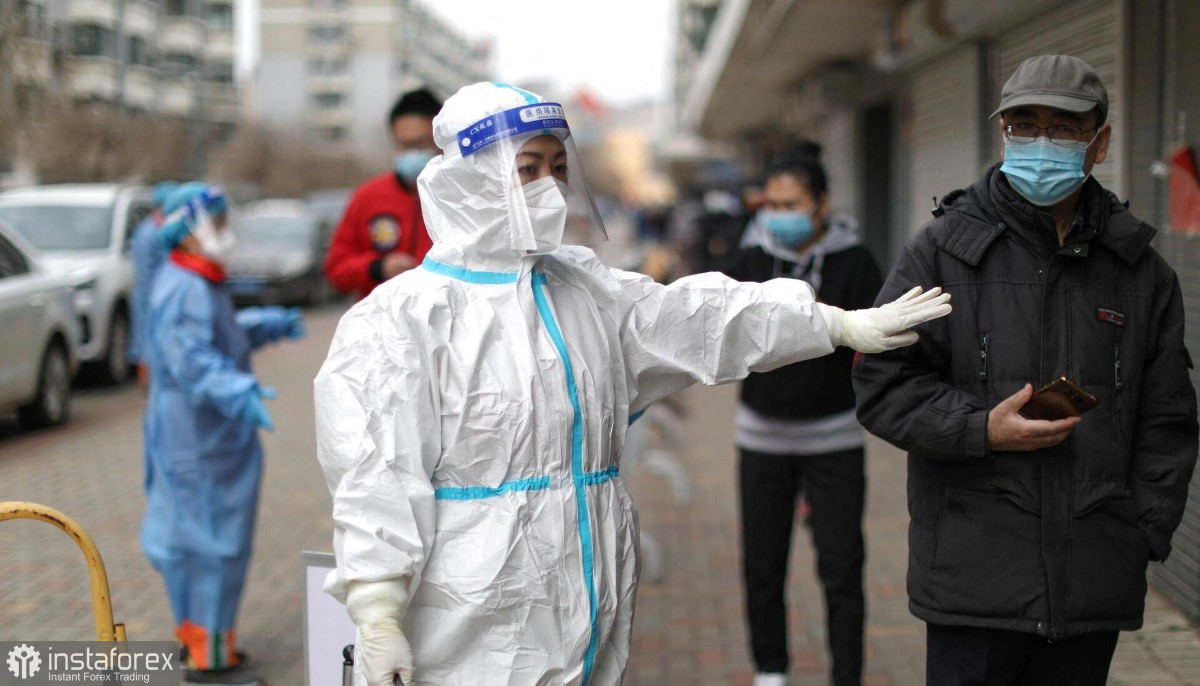Pressure on the euro and other risky assets is gradually increasing following news of the spread of a new wave of coronavirus. Beijing is already imposing strict isolation rules and mandatory additional testing measures. This led to panic in the city of 21 million people. Although the situation has now eased, the disruption to public transport continues. The authorities in Beijing have announced the need to work from home. It is not yet a complete lockdown, but stadiums, sports venues, cinemas, karaoke bars and other entertainment venues have already been closed. Concerns over the imposition of a full lockdown are fuelled by the situation observed in the southern business center of Shanghai, where quarantine restrictions have been eased slightly. Residents were only partially allowed to leave their homes after three weeks of lockdown. The city of Anyang in central China and Dandong on the border with North Korea were the latest to begin a lockdown due to the spread of a new strain of the coronavirus.

Serious problems due to quarantine observed in Shanghai have already affected supply chains, making them completely destabilized. As experts point out, China's strict rules to contain Covid-19 are about to cause a new wave of summer chaos in supply chains between Asia, the US and Europe. The blockages at Chinese ports, together with Russia's military special operation in Ukraine, risk several serious blows that threaten to derail the recovery of a global economy already suffering from high inflationary pressures and other growth restraints. Even if China deals with the coronavirus quickly, the disruptions will spread around the world for a year as overloaded cargo ships and ports return to normal operations.
According to the latest figures, China accounts for around 12% of world trade. Restrictions due to Covid have already led to idle factories and warehouses and slowed the delivery of goods. However, it is not just Chinese ports that are suffering; the US and Europe are experiencing similar problems, making those countries more vulnerable. All this is putting serious pressure on risky assets, which continue to lose ground fast against the USD. But before we get into the technical picture, I would like to say a few words about what could help them.
Goldman Sachs Group Inc. economists recently said they expected more aggressive action from the European Central Bank. They predict the regulator will raise interest rates by 25 basis points as early as July this year, before raising them in September and December. The ECB is also forecast to raise its key rate four more times in 2023 (to 1.25%). Given ongoing cost pressures and limited evidence of sustained demand contraction, the ECB's recent commentary highlights growing concerns, Goldman analysts said. The ECB is also projected to decide whether to end its asset purchase program as early as the end of the second quarter.
The euro continues to renew monthly lows and despite yesterday's strong German data, the situation is unlikely to change for the better anytime soon. Expectations of more aggressive European Central Bank policy are not helping the euro at all as everyone is waiting for the Federal Reserve meeting in May where interest rate may be increased by 0.75% against the previously announced 0.5%. Deteriorating geopolitical tensions due to Ukraine's refusal to negotiate will continue to limit the upside potential of risk assets. Therefore, it is best to bet on further dollar strength. To halt the bear market, buyers need to defend near-term support at 1.0700. If it misses, the bears are likely to take the instrument to new lows, 1.0640 and 1.0580. Further target is the support at 1.0530. The Euro can correct only after the bulls gain back control of the resistance at 1.0750. From there we might see an uptrend towards 1.0810 and 1.0850.
The pound continues to decline following recent comments by the governor of the Bank of England that governments should be prepared to accept economic hardship as payment for forcing Russia to end its military special operation in Ukraine. The case in point is the sanctions that have been adopted, which have seriously affected not only Russia, but also the EU countries and the UK. The governor of the Bank of England also said that the economy could soon slip into recession and that the country's population would face even more difficulties.
Against this background, the pound continues to fall, and so far no one can stop it. Buyers of risky assets tried to do something around 1.2730, but there are no prerequisites for hitting the bottom yet. There will be bounces up, but it is worth noting that the medium-term bearish trend is only gaining strength and intensifying. I advise selling the pound at every decent upward correction. The nearest resistance levels are now located around the 28th figure, and also a little bit higher, around 1.2860 and1.2910. A break of 1.2730 will only strengthen the bear market, which will open the way to new lows of 1.2680, 1.2640 and 1.2580. The furthest target in current conditions would be support at 1.2510, which would be renewed very quickly if the UK economy deteriorates.
 English
English 
 Русский
Русский Bahasa Indonesia
Bahasa Indonesia Bahasa Malay
Bahasa Malay ไทย
ไทย Español
Español Deutsch
Deutsch Български
Български Français
Français Tiếng Việt
Tiếng Việt 中文
中文 বাংলা
বাংলা हिन्दी
हिन्दी Čeština
Čeština Українська
Українська Română
Română

